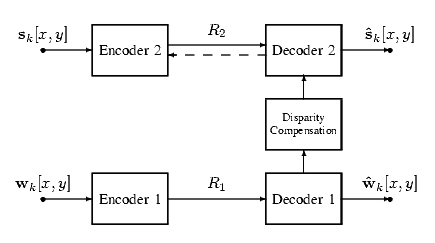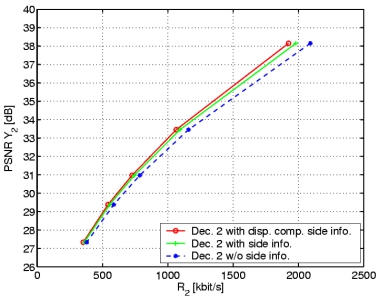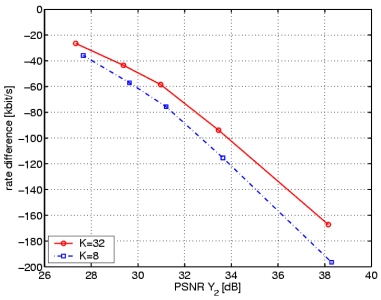Distributed Coding of Dynamic Scenes with
Motion-Compensated Wavelets
This work discusses distributed coding of two correlated video signals.
The video signals are captured from a dynamic scene where each signal
is temporally decorrelated by a motion-compensated Haar wavelet.
The two cameras operate independently, however, the central decoder is
able to exploit the coded information from all cameras to achieve the best
reconstruction of the correlated video signals.
The coding system utilizes nested lattice codes for the transform
coefficients and exploits side information at the decoder.
The efficiency of the decoder is improved by disparity compensation
of one video signal.
When compared to decoding without side information, decoding of the quantized
transform coefficients with disparity compensated side information improves
rate-distortion performance.
(Article)
1. Distributed Coding Scheme
Scene information that is acquired by more than one sensor can be coded
efficiently if the correlation among sensor signals is exploited.
In one possible compression scenario, encoders of the sensor signals
are connected and compress the sensor signals jointly.
In an alternative compression scenario, each encoder operates independently
but relies on a joint decoding unit that receives all coded sensor signals.
This is also known as distributed source coding.
A special case of this scenario is source coding with side information.
Wyner and Ziv showed that for certain cases the encoder does not need the
side information to which the decoder has access to achieve the
rate-distortion bound.

The figure depicts the distributed coding scheme for dynamic scenes.
The dynamic scene is represented by the image sequences
sk[x,y] and wk[x,y].
The coding scheme comprises of Encoder 1 and Encoder 2 that
operate independently as well as of Decoder 2 that is dependent on
Decoder 1.
The side information for Decoder 2 can be improved by considering
the spatial camera positions and performing disparity compensation.
As the video signals are not stationary, Decoder 2 is decoding with
feed-back.
2. Experimental Results
For the experiments, we select the stereoscopic MPEG-4 sequence
Funfair in QCIF resolution.
We divide each view with 224 frames at 30 fps into groups of K=32
pictures.
The GOPs of the left view are encoded with Encoder 1 at high
quality by setting the quantization parameter QP=2, where Q = 2 QP.
This coded version of the left view is used for disparity compensation.
The compensated frames provide the side information for Decoder 2
to decode the right view.
The left figure shows the luminance PSNR over the total bit-rate of the
distributed codec Encoder 2 for the sequences Funfair 2.
The sequence is the right view of the stereoscopic sequence.
The rate-distortion points are obtained by varying the quantization
parameter for the nested lattice in Encoder 2.
When compared to decoding without side information, decoding with
coefficient side information reduces the bit-rate by up to 5%.
Decoding with disparity-compensated side information reduces the bit-rate
by up to 8%.
Utilizing more accurate geometrical information about the scene will
improve the side information for Decoder 2 and, hence, will further
reduce the bit-rate of Encoder 2.
The right figure shows the bit-rate difference between decoding with side
information and decoding without side information over the luminance PSNR
at Decoder 2 for the sequence Funfair 2 (right view).
The bit-rate savings due to side information are depicted for weak temporal
filtering with K=8 pictures per GOP and strong temporal filtering
with K=32 pictures per GOP.
Note that both the coded signal (right view) and the side information
(left view) are encoded with the same GOP length K.
It is observed that strong temporal filtering results in lower
bit-rate savings due to side information when compared to the bit-rate
savings due to side information for weaker temporal filtering.
Obviously, there is a trade-off between the level of temporal decorrelation
and the efficiency of multi-view side information.
This trade-off is also found in the theoretical investigation on the
efficiency of video coding with side information.
Copyright Markus Flierl, July 15, 2004
|


